The Kingston A1000 NVMe SSD Review: Phison E8 Revisited
by Billy Tallis on July 2, 2018 8:00 AM ESTSequential Read Performance
Our first test of sequential read performance uses short bursts of 128MB, issued as 128kB operations with no queuing. The test averages performance across eight bursts for a total of 1GB of data transferred from a drive containing 16GB of data. Between each burst the drive is given enough idle time to keep the overall duty cycle at 20%.
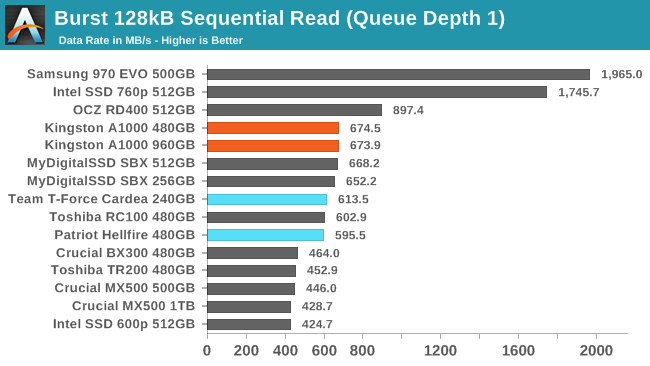
The burst sequential read performance of the Kingston A1000 can't match high-end NVMe SSDs, but as good as any other low-end NVMe SSD and significantly higher than what SATA drives can deliver. Performance is up slightly compared to the older Phison E7 drives that tried to be high-end for their time.
Our test of sustained sequential reads uses queue depths from 1 to 32, with the performance and power scores computed as the average of QD1, QD2 and QD4. Each queue depth is tested for up to one minute or 32GB transferred, from a drive containing 64GB of data.

On the sustained sequential read test, the Kingston A1000's standing drops substantially, with performance now lower than almost all NVMe SSDs. The 960GB A1000 is clearly slower than the smaller model, likely due to the extra overhead of managing so many NAND flash dies on a four-channel controller.
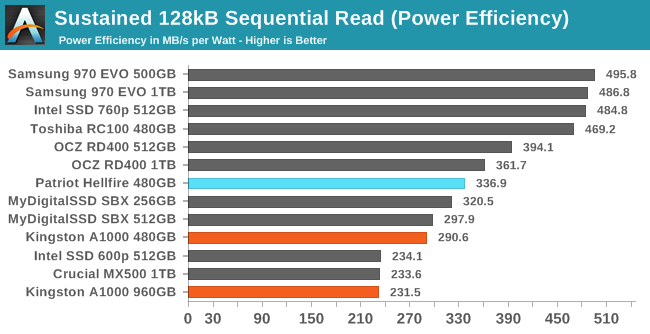 |
|||||||||
| Power Efficiency in MB/s/W | Average Power in W | ||||||||
The power consumption of the A1000 is relatively low by NVMe standards, but given its performance the efficiency ends up being quite poor, especially for the 960GB model.
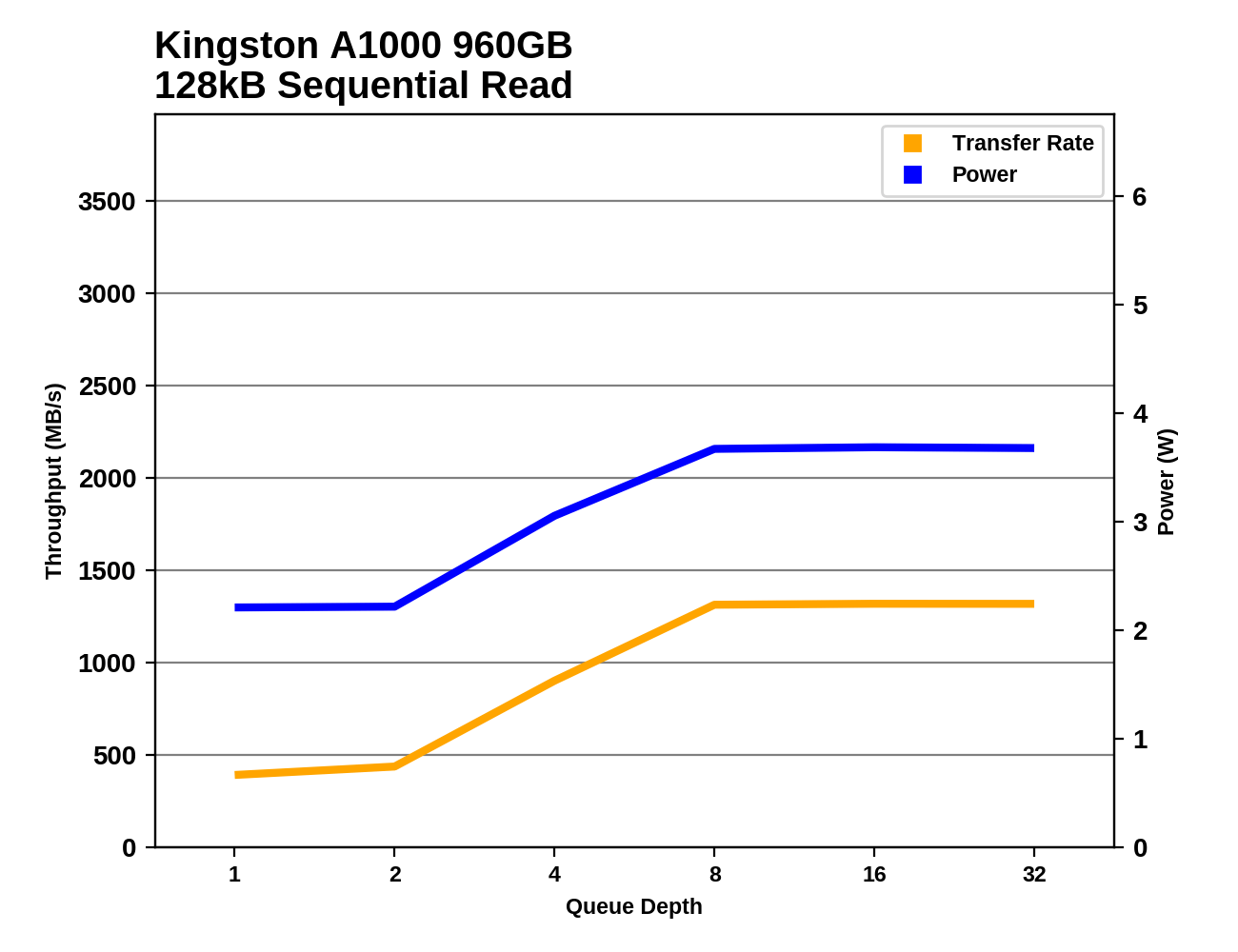 |
|||||||||
Quite a few SSDs show the same lack of scaling that the A1000 exhibits when increasing from QD1 to QD2. Beyond that, the A1000 scales up substantially to reach full speed at QD8, but it doesn't quite hit the advertised 1.5GB/s.
Sequential Write Performance
Our test of sequential write burst performance is structured identically to the sequential read burst performance test save for the direction of the data transfer. Each burst writes 128MB as 128kB operations issued at QD1, for a total of 1GB of data written to a drive containing 16GB of data.
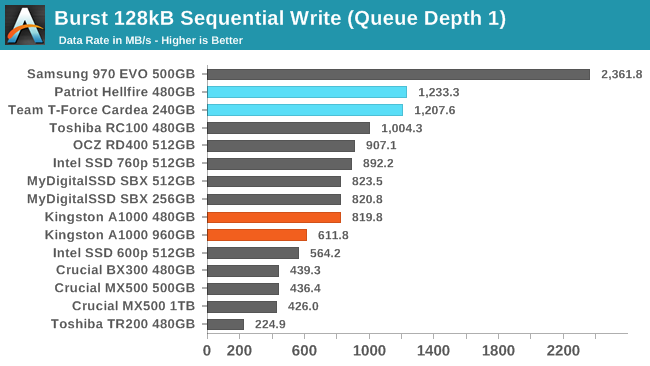
The larger 960GB Kingston A1000 has a much lower burst sequential write speed than the smaller model, which matches the MyDigitalSSD SBX. Even the slower A1000 is still significantly faster than a SATA SSD, but the high-end NVMe SSDs definitely deliver a different class of performance here. The Phison E7 drives are still quite competitive here and outperform all but Samsung.
Our test of sustained sequential writes is structured identically to our sustained sequential read test, save for the direction of the data transfers. Queue depths range from 1 to 32 and each queue depth is tested for up to one minute or 32GB, followed by up to one minute of idle time for the drive to cool off and perform garbage collection. The test is confined to a 64GB span of the drive.
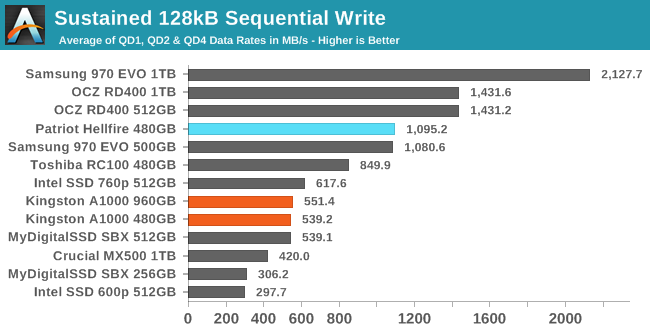
On the longer sequential write test, both capacities of the A1000 perform the same, and on par with the SBX. This puts them near the bottom for NVMe SSDs, but they're still staying beyond the reach of SATA SSDs. Performance is about half of what the Phisone E7 delivered with MLC NAND.
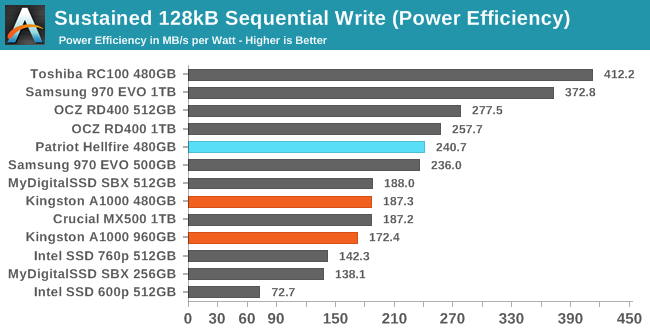 |
|||||||||
| Power Efficiency in MB/s/W | Average Power in W | ||||||||
The power efficiency of the Kingston A1000 isn't great: it is only about as good as decent SATA drives for sequential writes. Many NVMe SSDs are able to deliver much better power efficiency for sequential workloads where their PCIe interfaces allow for performance far in excess of what SATA can handle. The Toshiba RC100 is the best example of this, delivering more than twice the data per Watt.
 |
|||||||||
Sequential write performance from the Kingston A1000 is flat across the entire queue depth range, with full performance available at QD1 and no sign of problematic garbage collection cycles later in the test.










26 Comments
View All Comments
romrunning - Monday, July 2, 2018 - link
Any NVMe drive that doesn't beat the Intel 600p in every category shouldn't be made. I really wish all mfgs would keep NVMe drives to at least PCI x4 & 8 channels with a minimum performance level that is much higher than SATA. The bar for the next tech level of storage products should be at a higher level than the previous.Forget the low-end marked for NVMe. SATA can easily take care of any needs there.
peevee - Monday, July 2, 2018 - link
Given that only Samsung barely saturates PCIex2, and only on artificial tests, at this point even x4 is useless, let alone x8. They'll need many more channels.Actually, I'd prefer x1 for ultra-low-power, if it is fully saturated in more or less real-life tests (like AT's "Light"), vs x4 which only saturates 1/10th of x1 capacity.
romrunning - Tuesday, July 3, 2018 - link
I was thinking more along the lines of every mfg creating NVMe drives have to attain to a minimum performance level. It becomes easier to understand what is higher-performing from the end-user's perspective. So if NVMe's minimum performance level is 2x SATA, then anytime you see NVMe you know it's better than SATA. Too bad whatever storage consortium finalized specs for NVMe didn't require min perf levels for storage.It's annoy to me when these mfgs put out "new" drives that don't exceed the older tech.
FunBunny2 - Monday, July 2, 2018 - link
" I really wish all mfgs would keep NVMe drives to at least PCI x4 & 8 channels with a minimum performance level that is much higher than SATA. "some wag put it, "you sell the sizzle, not the steak".
Gunbuster - Tuesday, July 3, 2018 - link
Okay Kingston, reviews are done, feel free to swap in cheaper/slower NAND chips. ;)Ratman6161 - Tuesday, July 3, 2018 - link
In the ATSB Heavy Data Rate chart, for the 1TB 970 EVO, I think you have the full and empty numbers transposed. I.e. you show 525 empty and 635 full. I assume that should be 635 empty and 525 full?Billy Tallis - Tuesday, July 3, 2018 - link
They're not transposed. I'm not sure what happened with those test runs, but I'm re-running them. I do know that Samsung drives lie about when they've finished a secure erase, so it's possible the "empty" drive test run was still working on an erase operation in the background even though I try to ensure all drives have plenty of idle time to finish cleaning up after they claim to be done erasing.leexgx - Wednesday, July 4, 2018 - link
Surprised it works like that when using secure erase, zapping page area and all NAND chips should not take long to do, also what can i use to use secure erase on all drives (seagate own tool seems to lack it, it has full erase but it's not secure erase and it killed my seagate firecuda doing it)SanX - Tuesday, July 3, 2018 - link
Everyone here knows that in the shops the average Joe will see on the product tag "Sequential Read 1500 MB/s" which is plain lie and conveniently keeps mum about this. Which test gives 1500, show me? At best 2-3 times less.This site degraded long ago to serve salespeople.
rocky12345 - Wednesday, July 4, 2018 - link
Great review but this drive does seem rather unimpressive for sure. It acts like it doe snot have a dram cache at all since most if it's scores are well below the mark. I like Kingston for their memory products which work well in the systems I build for my clients. These NVMe drives that are considered lower end give a false picture of great speed and performance because NVMe drives are known for their great performance level. Then you get these drives trying to break into this sector and do not perform any where close to what you would expect from a NVMe drive. Heck my samsung 860 Pro 512GB Sata SSD can get better numbers in a lot of the tests done in the review than these cheap low end NVMe drives and it is only based off of the Sata port and limited to a max 600MB's from the port itself that is kinda sad if you think about it really.